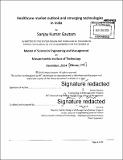| dc.contributor.advisor | Pat Hale. | en_US |
| dc.contributor.author | Gautam, Sanjay Kumar, S.M. Massachusetts Institute of Technology | en_US |
| dc.contributor.other | System Design and Management Program. | en_US |
| dc.coverage.spatial | a-ii--- | en_US |
| dc.date.accessioned | 2015-12-16T16:35:07Z | |
| dc.date.available | 2015-12-16T16:35:07Z | |
| dc.date.copyright | 2014 | en_US |
| dc.date.issued | 2015 | en_US |
| dc.identifier.uri | http://hdl.handle.net/1721.1/100375 | |
| dc.description | Thesis: S.M. in Engineering and Management, Massachusetts Institute of Technology, Engineering Systems Division, System Design and Management Program, February 2015. | en_US |
| dc.description | Cataloged from PDF version of thesis. | en_US |
| dc.description | Includes bibliographical references (page 77). | en_US |
| dc.description.abstract | Usage in information technology (IT) have improved efficiency and quality in many industries. Healthcare has not been one of them. Although some administrative IT systems, such as those for billing, scheduling, and inventory management, are already in place in the healthcare industry, little adoption of clinical IT, such as Electronic Medical Record Systems (EMR-S) and Clinical Decision Support tools, has occurred. India's healthcare information technology market is slow with technology adoption but there is little traction shown in last couple of years. This growth is expected to hit US $1.45 billion in 2018, more than three times the US $381.3 million reached in 2012. The increase in adoption of electronic health records, mHealth, telemedicine, and Web-based services has made electronic patient data expand, necessitating the implementation of robust IT systems in Indian healthcare institutions. Information technology (IT) has the potential to improve the quality, safety, and efficiency of health care. Diffusion of IT in health care is generally low (varying, however, with the application and setting) but surveys indicate that providers plan to increase their investments. Drivers of investment in IT include the promise of quality and efficiency gains. Barriers include the cost and complexity of IT implementation, which often necessitates significant work process and cultural changes. Given IT's potential, both the private and public sectors have engaged in numerous efforts to promote its use within and across health care settings. Delivering quality health care requires providers and patients to integrate complex information from many different sources. Thus, increasing the ability of physicians, nurses, clinical technicians, and others to readily access and use the right information about their patients should improve care. The purpose of this thesis is to assess the current state of healthcare in India and specifically look into the emerging technology trends in healthcare IT. During analysis secondary data has been used. Various articles and research papers published in national and international journals are used. India is hub of IT and its use is increasing in health sector. | en_US |
| dc.description.statementofresponsibility | by Sanjay Kumar Gautam. | en_US |
| dc.format.extent | 77 pages | en_US |
| dc.language.iso | eng | en_US |
| dc.publisher | Massachusetts Institute of Technology | en_US |
| dc.rights | M.I.T. theses are protected by copyright. They may be viewed from this source for any purpose, but reproduction or distribution in any format is prohibited without written permission. See provided URL for inquiries about permission. | en_US |
| dc.rights.uri | http://dspace.mit.edu/handle/1721.1/7582 | en_US |
| dc.subject | Engineering Systems Division. | en_US |
| dc.subject | System Design and Management Program. | en_US |
| dc.title | Healthcare market outlook and emerging technologies in India | en_US |
| dc.type | Thesis | en_US |
| dc.description.degree | S.M. in Engineering and Management | en_US |
| dc.contributor.department | System Design and Management Program. | en_US |
| dc.contributor.department | Massachusetts Institute of Technology. Engineering Systems Division | |
| dc.identifier.oclc | 931708106 | en_US |
